Beginner’s Guide to Starting E-commerce in MENA

Swipe, click, tap. That is how MENA is moving forward.
With internet adoption booming and national visions fueling the shift, the region is becoming one of the world's most exciting digital frontiers.
Local platforms like Amazon, Noon, and Jumia are thriving. But the market is still wide open with many customer needs not yet being met. For brands and sellers, this means one thing: opportunity.
But launching in MENA isn’t just about setting up an online store. You need to understand culture, payments, logistics, and what drives people to buy. Let’s explore how you can kickstart your e-commerce journey.
1. Understand the Market Landscape
Start by segmenting the region
MENA isn’t one size fits all. The Gulf states are wealthy, North Africa is populous, the Levant is diverse, and Egypt brings its own flavor. The UAE is nothing like Tunisia. You’ll need a flexible strategy for each market.
Get to know your customer
GCC shoppers prefer digital wallets and mobile checkouts. In Egypt and parts of North Africa, cash on delivery is still king. What works in Dubai may not fly in Cairo. Combine data with real conversations because local insight matters.
Spot the gaps
There’s room for niche players. Think halal beauty, eco-friendly everyday items, curated subscription boxes, or unique tech accessories. A strong niche can make you stand out.
Study your competition
Look at what’s already out there. How do they price? What’s their shipping like? What about customer support or returns? Then ask how you can do it better.
2. Choose Products Strategically
Focus on real value
Pick products that solve everyday problems or fill lifestyle gaps. Align with local tastes and test your offering in small batches. Let customer feedback shape the next step.
Stay out of saturated categories
Low-cost electronics and basic clothing are already flooded. Unless you have a clear edge, it’ll be tough to compete. Look for underserved product areas instead.
Think seasonal
Holidays like Ramadan, Eid, UAE National Day, and back-to-school are prime times to boost sales. Plan campaigns around these high-spending periods.
3. Pick the Right Business Model
Start with a marketplace
Platforms like Amazon, Noon, and Jumia help you go live quickly without building your own site. But they take a cut and limit how much control you have over your brand.
Build your own store
Using Shopify, WooCommerce, or a custom platform gives you full control over branding, user experience, and customer data. It takes more work, but you own the customer journey.
Mix and match
Many brands start on marketplaces to test the waters, then launch their own site once they see demand. This hybrid approach helps you scale smartly.
4. Build a Local Trustworthy Store
Make mobile your top priority
Mobile accounts for over 60% of traffic in places like Saudi Arabia and Egypt. Your site needs to load fast and work smoothly on all devices, even with slower internet.
Offer both Arabic and English
Translate everything properly from product pages to FAQs. Skip the auto translators. A native tone builds trust.
Invest in visuals
Good product photos matter. Add videos if you can. Write clear descriptions that explain how to use the product, what it’s made of, and why it fits local needs.
Keep checkout simple
Be upfront about shipping and taxes. No hidden charges. Keep forms short and offer autofill options to reduce drop-offs.
Show trust signals
Use SSL certificates, payment badges, and local trust seals like Mada Secure or Fawry Certified. Customer reviews go a long way, too.
5. Set Up Smooth Payments
Use local payment options
In Saudi Arabia, most people use Mada cards. In Egypt, Fawry and cash vouchers are still popular. Make sure your checkout supports local favorites.
Include Cash on Delivery
COD is still common, especially outside big cities. It’s riskier but expected. You can offer perks like discounts or faster delivery for customers who pay online.
Choose the right payment gateway
Look for gateways that support local methods, BNPL, and wallet integrations. The easier you make it to pay, the fewer abandoned carts you’ll see.
Offer installment options
BNPL is gaining ground in GCC countries. It helps increase basket size and reach higher spending customers.
6. Get Logistics Right
Know the challenges
Addresses aren’t always exact. Some areas have spotty delivery coverage. Cross-border shipping can mean delays and duties. And returns are more frequent than you might expect.
Pick your fulfillment strategy
In-house gives you full control, but scaling can be tough. Third-party providers like Aramex, Fetchr, and DHL eCommerce are common. Amazon and Noon also offer fulfillment services.
Make packaging a priority
Deliver orders safely and professionally. Use branded or eco-friendly packaging. Include invoices and tracking info because it builds trust.
Set clear return policies
Explain timelines, refund processes, and who handles returns. Sometimes, offering free returns even for select items can boost conversions.
7. Build a Strong Marketing Engine
Start with helpful content
Tell stories. Share product how tos. Post customer experiences. This builds credibility and helps people connect with your brand.
Go visual on social
TikTok, Instagram, and Snapchat are huge in MENA. Use short videos with Arabic text overlays to grab attention. Unboxings, product demos, and behind-the-scenes. work well.
Run paid ads smartly
Test low-budget campaigns. Use Arabic and English creatives. Target by city. Retarget people who abandoned their carts. Keep refreshing your ads to stay relevant.
Work with micro influencers
Smaller influencers often get better engagement. They know the local audience and speak the dialect. Their content feels more relatable and authentic.
Use email and messaging
Send welcome emails, cart reminders, and order updates. Use WhatsApp or SMS for quick nudges. Keep your messages short and sweet. Offer perks to keep people coming back.
8. Deliver Great Customer Experience
Offer quick, friendly support
Be available on WhatsApp, live chat, or local numbers. Respond fast, especially before purchase. Arabic support is a big plus.
Be transparent with returns
Make your refund process easy to understand. Inform people about the expected duration, the refund process, and who covers shipping costs.
Show off your reviews
Display real customer feedback, even for minor issues, as long as they have been resolved. It builds credibility.
Follow-up post-purchase
Send a thank you note or a message with shipping updates. Personal touches like mentioning the customer’s city can build loyalty.
9. Use Data to Improve
| Focus Area | What to Do | Why It Matters |
|---|---|---|
| Track key metrics | Monitor traffic, product views, drop-offs, repeat buys, and returns. Use Google Analytics and your payment provider. | Reveals what drives conversions and where customers drop off. |
| Listen to feedback | Use surveys, reviews, and messages to gather input. | Helps improve listings, images, sizing, and overall experience. |
| Run A/B tests | Test headlines, images, buttons, and offers. | Small tweaks can lead to major performance gains. |
| Refine your catalog | Adjust products by region based on sales data. | Matches demand, reduces waste, and improves ROI. |
10. Plan for Growth
Nail one market first
Don’t rush. Build trust, smooth operations, and solid messaging in one country before moving to the next.
Localize for each new market
What works in Saudi Arabia won’t work the same in Egypt. Payment habits, regulations, and tone all change. Customize your plan for each country.
Get involved locally
Join events. Collaborate with startups or universities. Offer internships. Local presence equals stronger brand trust.
Diversify your revenue streams
Add subscriptions, B2B partnerships, or wholesale options. This cushions your business during slow seasons or market shifts.
New to E-commerce in MENA? We’ll Help You Start Smart
The Middle East and North Africa offer huge potential, but getting started means more than just launching a store. You need the right insights, tools, and local know-how.
At Click2MENA, we guide beginners through every step, from market research to first sale. Book a call with our team of experts today and turn your e-commerce idea into action.




